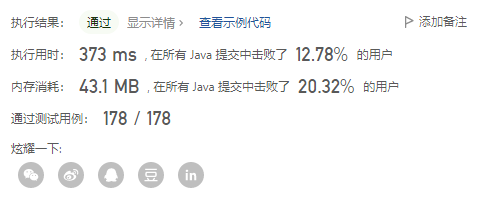1)题目
给定一个字符串 s 和一个字符串数组 words。 words 中所有字符串 长度相同。
s 中的 串联子串 是指一个包含 words 中所有字符串以任意顺序排列连接起来的子串。
- 例如,如果
words = ["ab","cd","ef"], 那么"abcdef","abefcd","cdabef","cdefab","efabcd", 和"efcdab"都是串联子串。"acdbef"不是串联子串,因为他不是任何words排列的连接。
返回所有串联字串在 s 中的开始索引。你可以以 任意顺序 返回答案。
示例 1:
输入:s = “barfoothefoobarman”, words = [“foo”,“bar”]
输出:[0,9]
解释:因为 words.length == 2 同时 words[i].length == 3,连接的子字符串的长度必须为 6。
子串 “barfoo” 开始位置是 0。它是 words 中以 [“bar”,“foo”] 顺序排列的连接。
子串 “foobar” 开始位置是 9。它是 words 中以 [“foo”,“bar”] 顺序排列的连接。
输出顺序无关紧要。返回 [9,0] 也是可以的。
示例 2:
输入:s = “wordgoodgoodgoodbestword”, words = [“word”,“good”,“best”,“word”]
输出:[]
解释:因为 words.length == 4 并且 words[i].length == 4,所以串联子串的长度必须为 16。
s 中没有子串长度为 16 并且等于 words 的任何顺序排列的连接。
所以我们返回一个空数组。
示例 3:
输入:s = “barfoofoobarthefoobarman”, words = [“bar”,“foo”,“the”]
输出:[6,9,12]
解释:因为 words.length == 3 并且 words[i].length == 3,所以串联子串的长度必须为 9。
子串 “foobarthe” 开始位置是 6。它是 words 中以 [“foo”,“bar”,“the”] 顺序排列的连接。
子串 “barthefoo” 开始位置是 9。它是 words 中以 [“bar”,“the”,“foo”] 顺序排列的连接。
子串 “thefoobar” 开始位置是 12。它是 words 中以 [“the”,“foo”,“bar”] 顺序排列的连接。
提示:
- 1 <= s.length <= 104
- 1 <= words.length <= 5000
- 1 <= words[i].length <= 30
- words[i] 和 s 由小写英文字母组成
来源:力扣(LeetCode)
链接:https://leetcode.cn/problems/substring-with-concatenation-of-all-words
著作权归领扣网络所有。商业转载请联系官方授权,非商业转载请注明出处。
2)思路
先取出 words.length长度的字符串,再从中取出words[i].length长度的字符串,跟数组进行比较,包含则去掉这个字符串。一轮结束后字符串数组为空时,保存这个 words.length长度的字符串 第一个字母的下标。
暂时想不到其他方法,先这样吧。
3)代码
public static List<Integer> findSubstring(String s, String[] words) {
List<Integer> result = new ArrayList<>();
int length = words.length;
int strLength = words[0].length();
int wordLength = length * strLength;
List<String> list;
for (int i = 0; i < s.length(); i++) {
if (i + wordLength > s.length()) break;
String substring = s.substring(i, i + wordLength);
list = new ArrayList<>(Arrays.asList(words));
for (int j = 0; j < substring.length(); j+=strLength) {
int index = list.indexOf(substring.substring(j,j+strLength));
if (index == -1) break;
list.remove(index);
}
if (list.size() == 0) result.add(i);
}
return result;
}
初步优化
public static List<Integer> findSubstring(String s, String[] words) {
List<Integer> result = new ArrayList<>();
int length = words.length;
int strLength = words[0].length();
int wordLength = length * strLength;
List<String> list;
for (int i = 0; i < s.length(); i++) {
if (i + wordLength > s.length()) break;
list = new ArrayList<>(Arrays.asList(words));
for (int j = i; j < i + wordLength; j += strLength) {
int index = list.indexOf(s.substring(j, j + strLength));
if (index == -1) break;
list.remove(index);
}
if (list.size() == 0) result.add(i);
}
return result;
}
4)结果

初步优化结果























 473
473











 被折叠的 条评论
为什么被折叠?
被折叠的 条评论
为什么被折叠?








